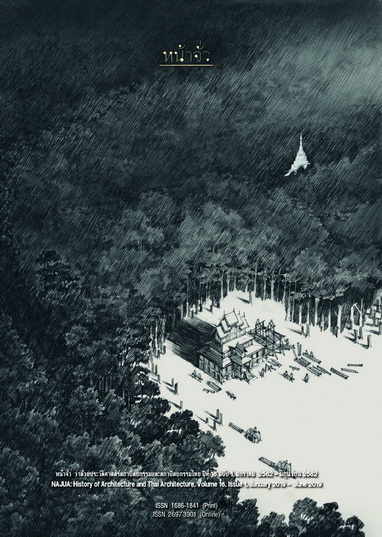Nakhon Ratchasima: A Study of the Old Town through its History, Settlement, and Architectural Heritage.
Main Article Content
Abstract
This article studies the Nakhon Ratchasima old town through the lenses of settlement, town planning, architectural style, and old house conservation. The authors investigated the city’s origins using survey research, historical research, and in-depth interviews coupled with primary and secondary documentary research. Our findings show that Nakhon Ratchasima has had an international relationship with neighboring countries relevant to the development of each. Two illustrations of this international context are: the emerging city was the focus of Siam’s first rail routes, acting as a fortress between Laos and Cambodia, and the city’s involvement in the kingdom’s political problems. There are 7 architectural styles present in the city: the clay house, wooden shophouse, Western influenced wooden shophouse, and bungalow, vernacular, sino-colonial, and modern. The popularity of each type depended on the way of life, ethnicity, and social life of the people building and using these buildings. These many layers of architecture show these changes over time. Early important vernacular buildings became covered by shophouses as new owners built new layers of history for their businesses. Unfortunately, some of the architectural history has been erased by demolition when people lacked a knowledge of local history. Meanwhile, we discovered the chronological importance of many historical layers: from Khmer civilization to Ayutthaya to Rattanakosin. The findings of this research can act as a model to improve the conservation of important places, to create community awareness about the significance of places, and to make residents proud of their home towns. This living heritage is evident in each layer of settlement, providing pieces of the giant jigsaw puzzle to gradually fill in the city’s history.
Downloads
Article Details
References
Aymonier, Etienne. Khmer Heritage in Thailand. Bangkok: White Lotus, 1999.
Chatri Prakitnonthakan. kānmư̄ang læ sangkhom nai sinlapa sathāpattayakam Sayām samai Thai prayuk chātniyom
[Politics and Society in Art and Architecture: The Era of Siam, Transformed Thai, and Nationalism]. 2nd ed. Bangkok: Matichon, 2007.
Chewin Pestonji, Bancha Nakthong and Prasit Tophoklang. sathāpattayakam rư̄an panyā læ rư̄an manilā nai khēt mư̄ang Nakhō̜n Rātchasīmā [The Architecture of Hip Roof and Gable Roof in Nakhon Ratchasima Municipal]. Nakhon
Ratchasima: Faculty of Architecture, Rajamangala University of Technology Isan, Northeastern Campus, 2005.
Damrong Rajanubhab, H.R.H. Prince. nithān bōrānnakhadī [Tales of Archeology]. Bangkok: Thai Quality Books, 2013.
Danai Nilsakul. “kānčhat phư̄nthī chaisō̜i phāinai tưk din : kō̜ranī sưksā nai khēt ʻĪsān tai [Spatial Usage in Earthen
Dwellings: A Case Study in Southern Isan].” Journal of Mekong Societies. 2, 2 (May-August 2006): 23-37.
Kachirat Airawanawat. “khwāmsamkhan thāngkān mư̄ang khō̜ng mư̄ang Nakhō̜n Rātchasīmā: botbāt khō̜ng čhao mư̄ang trakūn Na rāt sīmā rawāng Phō̜.Sō̜. 2325-2388 [The Political Importance of Nakhon Ratchasima in the Early Bangkok Period: A Study of the Role of the Na Ratchasima Ruling Family, 1782-1845].” Master’s Thesis, Silpakorn University, 1989.
Kachon Sukpanich. khō̜mūn prawattisāt: samai ʻAyutthayā [Ayutthaya Historical Document]. Bangkok: Thammasat Publishing House, 1980.
Kakizaki, Ichiro “rotfai kap kānrūamtūa thāng sētthakit khō̜ng Thai nai samai kō̜n songkhrām lōk khrang thī sō̜ng [The Integration of Thai Train and Economic Integration of in the Pre-World War II Period].” Journal of the Historical Society, no. 29 (2007): 1-45.
Kamthon Laengsajatham, ed. kotmāi trā sām dūang chabap phim mahāwitthayālai wichāthō̜n rom sāt læ kānmư̄ang lem nưng [The Three Seals Code, Political and Law University Version, Vol. 1. Bangkok: Pridi Banomyong Institute, 2004.
Katanyu Hawsutisima. “nǣothāng kānphatthanā thāng kāiyaphāp bō̜riwēn rō̜p ʻanusāwarī thāosuranārī čhangwat Nakhō̜n Rātchasīmā [The Development Guidelines for Tau-Suranaree Monument Area, Nakhon Ratchasima Province.” Master’s Thesis, Chulalongkorn University, 2002.
Loubere, La De. A New Historical Relation of the Kingdom of Siam. Bangkok: White Lotus, 1986.
McCarthy, James. Surveying and Exploring in Siam. Bangkok: White Lotus, 1994.
Ministry of Natural Resources and Environment. The National Committee of Rattanakosin Island and Old Town Conservation. khrōngkān kamnot khō̜pkhēt phư̄nthī mư̄ang kao mư̄ang Nakhō̜n Rātchasīmā [Drawing the Boundaries of Old Towns Project : Nakhon Ratchasima Old Town]. Bangkok: Office of Natural Resources and Environmental Policy and Planning, 2015.
Nakhon Ratchasima Chamber of Commerce. yō̜nrō̜i nưngrō̜i pī Khōrāt wānit [The 100 years of Korat Trader]. Bangkok: Future Press and Media, 1998.
Phillips, Matthew. Thailand in the Cold War. NewYork: Routledge, 2016.
Pratheep Malakul. phatthanākānbān khō̜ng Khon Thai nai phāk klāng [The Development of Central Thai Housing]. Bangkok: Chulalongkorn University Printing Press, 1987.
Somdej Leelamanotam. “Nakhon Ratchasima Citadel.” Conference Documents, National Heritage Asset Management with Local Government Organizations in Nakhon Ratchasima Province, at Suranaree A. Meeting Room, Royal Princess Hotel, March 14-15, 2002.
Thanom Kittikachon. kān pai yư̄an phāk ʻĪsān khō̜ng khāphačhao [My Isan’s Journey]. Phra Nakorn: Ruam Mit Thai
Printing Press, 1958.
thīralư̄k ngān sop nāng Ladawan wan būn [Memory Book for Funeral of Mrs. Laddawal Wannaboon]. Nakhon Ratchasima: n.p., 2013.
Thongchai Winichakul. Siam Mapped: A History of the Geo-Body of a Nation. Honolulu: University of Hawaii Press, 1994.
Weiler, Luis. kamnoēt kān rotfai nai prathēt Thai [The Origin of State Railway of Thailand]. 2nd ed. Translated from
Anfang der Eisenbahn in Thailand. Translated by Thanomnuan Ocharoen and Wilita Sriuranpong. Bangkok: Chulalongkorn University, 2013.
Wyatt, David K. prawattisāt Thai chabap sangkhēp [Thailand: A short History]. Translated from Thailand: A Short History. Translated by Kanchanee La-ongsri. Bangkok: The Foundation for the Promotion of Social and Humanities Textbooks Project, 2013.
Interview
Ithipol Kamphiranont. Kamphiranont Heir. Interview, June 1, 2562.
Kongsak Angsuphan. A Thai-Chinese in Nakhon Ratchasima. Interview, 2562.
Somdech Leelamanotham. Head of Phimai Historical Park, the Nakhon Ratchasima City Wall excavated archeologist. Interview, April 17, 2019.
Thanongsak Hanwong. Former Technical Officer, Fine Arts Department. Interview, April 18, 2562.
Weena Raksasap. Retired Lecturer. Interview, March 7, 2562.


